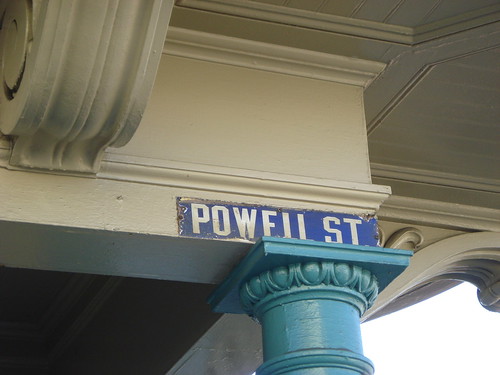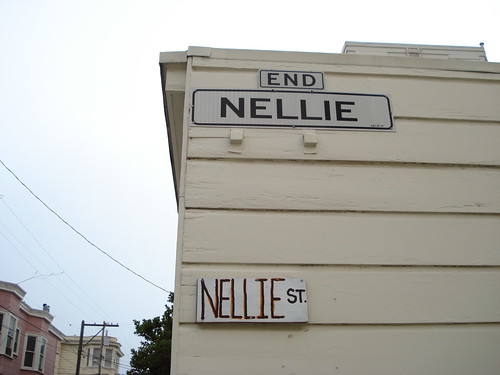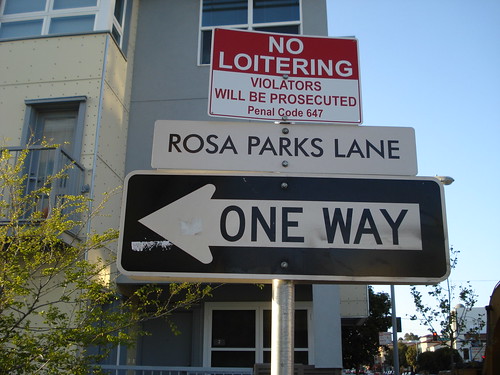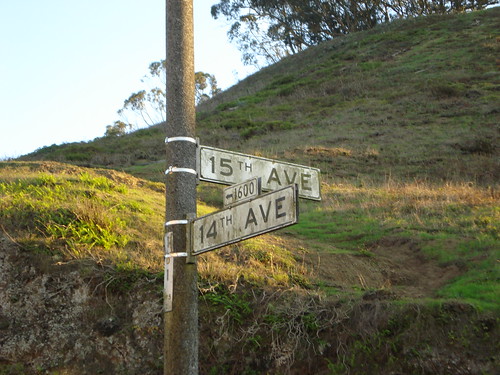1899.Another day, a new correspondent, and a new addition to the League of Extraordinary Street Sign Bloggers. I'd like to introduce you all to the collection of one Eric Fischer, habitué of the streets (and signs thereon) of San Francisco.
The design of the San Francisco street blade is unique, at least to this Oregonian. The most notable thing is what it doesn't contain: the generic (or street type). The only name on an SF street blade is the specific name (actual street name); for instance, one must know a priori that Grove is a Street as opposed to an Avenue.
I'm guessing.
The real cool thing about SF street blades is how user-friendly they are. You know that this is the 500 block of Grove and which the direction of increase; you know that that is the 600 block of Octavia and the direction of its increase. Knowing basic facts about SF geography also tells you which direction to go to get in the general direction of downtown, though a bit of local knowledge is necessary; I've never been to SF, but I know enough about it to know that if you're in the area in the northwest corner of the city, I believe it's called "The Avenues", the block tells you how far west of the street's beginning you are.
There's another tricky thing about SF of which I'm aware. While there's a standard 100-numbers to the city block going, and there are several gridironed areas, the blocks on those streets relate to the nearest baseline, not the grid.
Here's an example. Anyone with a passing knowledge of SF knows how important a street Market Street is. It's not only an important dividing line between neighborhoods and city sections, but it's also the address base for that area.
Read up Google maps and zoom in to the area of Market where Geary, Ofarrell (I find it interesting that Ofarrell is apparently official spelt without an apostrophe ("O'Farrell"), but that's another program). If you zoom in close enough you'll find that all addresses north of Market depend on how many blocks north or west of Market you are. Since Market runs on a diagonal against those streets north of it, the address blocks don't stay constant north-south-east-west, they actually stagger in parallel to Market.
For example, the block of Geary between Market/Kearny and Grant is the 10's block, between Grant and Stockton is the 100 block, and Stockton to Powell is 200. However, the street paralelling Geary to the south, Ofarrell, has the 10's between Market/Grant and Stockton, and 100s between Stockton and Powell. The same block of adjacent parallel streets in that area is offset by +100 as you go north from Market, and +100 similarly as you travel west from Market. The areas south of Market respect its own grid only because the streets are perpendicular and parallel to Market.
Well, enough dry address grid talk, let's see a few of the treats that Eric has gathered. His flickr stream includes these gems:

Unlike Portland, SF has preserved a great number of its oldstyle street signs, something I wish Portland had done. This is a particularly charming example.
Also, if you're at the end of a street, you know it for sure:

Not only do the old signs get nailed to buildings, the new ones do too. And it looks like a local either just predated or postdated the installation.
I just love that tab with the END on it. Nothing like it anywhere else that I've seen.
I enjoy this pair of blades:

Which suggests that Stanford Heights begins at Melrose, and the beginning of Melrose is off the left a few blocks.
And, apparently, SF has its own street renaming fashion after notable notables from US history, but does it nonstandardly:

The lettering looks a little Futuraish to me.
Eric's flickr stream is called WalkingSF, which means it's not just SF street signs and blades (though there are a lot) there's a great deal of just nifty street and architecture pics of San Fran, and by the end, you feel lilke you've walked around SF with Eric for a while, and it's an interesting walk.
Of course, I couldn't leave it without sharing this:

Of course, if 15th Ave and 14th Ave are one block apart, it's a simple matter to make it curve to the side one block if you want to tee it off. But being able to say "The corner of 14th and 15th" just has that absurd sound to it.
As I said, Eric's flickr stream, WalkingSF, is here.
He has a LJ blog here (he learned about our Great Renaming from me). Of course, both links are now in the sidebar.
Enjoy, signfans! Thanks, Eric!
Technorati Tags: street blades, san francisco, san francisco street blades, street blade design, sign design
The design of the San Francisco street blade is unique, at least to this Oregonian. The most notable thing is what it doesn't contain: the generic (or street type). The only name on an SF street blade is the specific name (actual street name); for instance, one must know a priori that Grove is a Street as opposed to an Avenue.
I'm guessing.
The real cool thing about SF street blades is how user-friendly they are. You know that this is the 500 block of Grove and which the direction of increase; you know that that is the 600 block of Octavia and the direction of its increase. Knowing basic facts about SF geography also tells you which direction to go to get in the general direction of downtown, though a bit of local knowledge is necessary; I've never been to SF, but I know enough about it to know that if you're in the area in the northwest corner of the city, I believe it's called "The Avenues", the block tells you how far west of the street's beginning you are.
There's another tricky thing about SF of which I'm aware. While there's a standard 100-numbers to the city block going, and there are several gridironed areas, the blocks on those streets relate to the nearest baseline, not the grid.
Here's an example. Anyone with a passing knowledge of SF knows how important a street Market Street is. It's not only an important dividing line between neighborhoods and city sections, but it's also the address base for that area.
Read up Google maps and zoom in to the area of Market where Geary, Ofarrell (I find it interesting that Ofarrell is apparently official spelt without an apostrophe ("O'Farrell"), but that's another program). If you zoom in close enough you'll find that all addresses north of Market depend on how many blocks north or west of Market you are. Since Market runs on a diagonal against those streets north of it, the address blocks don't stay constant north-south-east-west, they actually stagger in parallel to Market.
For example, the block of Geary between Market/Kearny and Grant is the 10's block, between Grant and Stockton is the 100 block, and Stockton to Powell is 200. However, the street paralelling Geary to the south, Ofarrell, has the 10's between Market/Grant and Stockton, and 100s between Stockton and Powell. The same block of adjacent parallel streets in that area is offset by +100 as you go north from Market, and +100 similarly as you travel west from Market. The areas south of Market respect its own grid only because the streets are perpendicular and parallel to Market.
Well, enough dry address grid talk, let's see a few of the treats that Eric has gathered. His flickr stream includes these gems:

Unlike Portland, SF has preserved a great number of its oldstyle street signs, something I wish Portland had done. This is a particularly charming example.
Also, if you're at the end of a street, you know it for sure:

Not only do the old signs get nailed to buildings, the new ones do too. And it looks like a local either just predated or postdated the installation.
I just love that tab with the END on it. Nothing like it anywhere else that I've seen.
I enjoy this pair of blades:

Which suggests that Stanford Heights begins at Melrose, and the beginning of Melrose is off the left a few blocks.
And, apparently, SF has its own street renaming fashion after notable notables from US history, but does it nonstandardly:

The lettering looks a little Futuraish to me.
Eric's flickr stream is called WalkingSF, which means it's not just SF street signs and blades (though there are a lot) there's a great deal of just nifty street and architecture pics of San Fran, and by the end, you feel lilke you've walked around SF with Eric for a while, and it's an interesting walk.
Of course, I couldn't leave it without sharing this:

Of course, if 15th Ave and 14th Ave are one block apart, it's a simple matter to make it curve to the side one block if you want to tee it off. But being able to say "The corner of 14th and 15th" just has that absurd sound to it.
As I said, Eric's flickr stream, WalkingSF, is here.
He has a LJ blog here (he learned about our Great Renaming from me). Of course, both links are now in the sidebar.
Enjoy, signfans! Thanks, Eric!
Technorati Tags: street blades, san francisco, san francisco street blades, street blade design, sign design
Powered by ScribeFire.


2 comments:
Thanks for the interest and the publicity!
You're right that you have to just know that Grove is a Street instead of an Avenue, but in practice, you rarely actually have to know, because (thanks to the 1909 renamings) there are very few cases where there is any ambiguity. The exception is the numbered streets and avenues, which do get "ST" or "AVE" on the sign. But people will refer to intersections like "19th and Mission" or "19th and Judah", with the expectation that you will know that the former is 19th Street and the latter is 19th Avenue. Occasionally the suffix does appear on the signs (like on these ones for Geary and Ohlone), for no clear reason.
The apostrophe in O'Farrell does appear on street signs, even if not in Google Maps. I'm surprised to see it also missing in the official city GIS maps.
Rosa Parks is actually a new street (through the rebuilt Valencia Gardens housing project), not a renaming, although it was apparently a late decision because a fire department map on one of the buildings calls it Valencia Lane (violating the no-ambiguity rule!) instead. The more typical commemorative renamings (like the block of 16th renamed for Jose Sarria) put the new name in large letters and the original name in small letters, usually in parentheses, below. There must be a limit to how long the old names remain valid because recently-replaced signs on Cesar Chavez no longer say Army at the bottom.
I'm glad you liked the picture of 14th and 15th! 3rd Street is the main offender of this type, intersecting other numbered streets from 16th to 26th.
Seems like a lot of growing west coast cities had to go through a Great Renaming of some sort.
In Portland's, case, it came as a result of two major events; one, the consolidation of the three major cities in 1890 to create the modern City of Portland (the cities named their streets independently of each other), the other, the ongoing practice of allowing developers to name streets in thier subdivisions whatever they pleased. This led to more than ten First Streets by the time the citizens got sick of it.
The SF renaming was obviously very thorough, and that's to the planners' credit.
In some cities, like Portland, it's good to know whether your on a Street or Avenue, because since the standard Street runs east-west and the standard Avenue runs north-south, it's a great device to help you find your way around, especially in the North quadrant, where all streets are prefixed N and all streets and avenues have names (not a number amongst them).
It looks like you have to 'get to know' SF up close, and from what I've heard of the town, that's just the way to do it.
That way of dual-signing honorary streets is certainly unique, but what caught my eye on the Jose Sarria sign was the way the type seemed to be in Helvetica.
I don't know if you've been reading about it, but we've been arguing for a while up here in PDX about street renaming. After MLK got a street named for him, it created such an argument that the city council came out with painstaking, careful rules to ensure that a majority of everyone was on board if they ever did that again ... then proceeeded to fast-track every renaming since, which is why we now have Naito Parkway instead of Front Avenue (over many objections) and Rosa Parks Way instead of Portland Boulevard (over louder objections of neighbors who tend to say they were ignored).
When Mayor Potter (the last mayor) decided to give an interest group a gift by fast-tracking a renameing of N. Interstate Avenue to Cesar Chavez Boulevard, the citizens of north Portland finally got loud and said "enough already", and it became a city wide argument.
Nobody was more dismayed than Mayor Potter. After all, wasn't the street-naming process there for the sake of argument (so to speak)?
I don't have any problem at all with names like Rosa Parks Way and Cesar Chavez Blvd. My problem was with the way carefully worked-out rules were sidetracked to name streets after fashionable memorial names, and the irony that those names are people who believed that the law should work the way it was supposed to was not lost on me.
You mentioned:
There must be a limit to how long the old names remain valid because recently-replaced signs on Cesar Chavez no longer say Army at the bottom.
In our town, the old street blades are mounted with the new ones for five years after renaming. The comparatively-tiny "NE Union Ave" sign looked odd perched across the yardstick-like "NE Martin Luther King JR Blvd" blade.
I've always like the way they do it in Chicago: a second blade carries the honorary name with the word "honorary" in front, and the old name is retained. I saw a picture, for instance, of an "Honorary Siskel & Ebert Way". I thought that was classy.
You:
'm glad you liked the picture of 14th and 15th! 3rd Street is the main offender of this type, intersecting other numbered streets from 16th to 26th.
I do enjoy the absurdity of it, that's true. I think we have kindred eyes in that way, you and I.
For those who just joined the discussion, the reason that is is because 3rd Street south from Market comes up against SF Bay and begins running N-S, where the other streets number off to the west and Market turns N-S west of the city center. Numbered streets, however, still branch perpedicularly off Market, perforce running due E-W to instersect 3rd street, which runs along the bay.
Anyone who doesn't have one should get a map of SanFran and lay it out. You can get lost in it.
Post a Comment